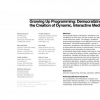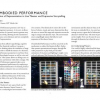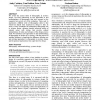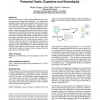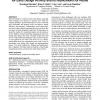105
Voted
CHI
2009
ACM
15 years 7 months ago
2009
ACM
Young people interact with games, animations, and simulations all of the time. But few of them are able to create interactive media. The obstacle: traditional programming language...
88
Voted
CHI
2009
ACM
15 years 7 months ago
2009
ACM
ion of Representation in Live Theater PPPPETERETERETERETER TTTTORPEYORPEYORPEYORPEY Opera of the Future, MIT Media Lab Disembodied Performance presents a new way to think about exp...
61
Voted
CHI
2009
ACM
15 years 7 months ago
2009
ACM
82
Voted
CHI
2009
ACM
15 years 7 months ago
2009
ACM
Eliciting user preferences for large datasets and creating rankings based on these preferences has many practical applications in community-based sites. This paper gives a new met...
90
Voted
CHI
2009
ACM
15 years 7 months ago
2009
ACM
We propose a new perspective, seeing interactivity that is the immaterial part of an interactive artifact as something concretely describable and perceivable as we do with physica...
101
Voted
CHI
2009
ACM
15 years 7 months ago
2009
ACM
We review the current status of ethnography in systems design. We focus particularly on new approaches to and understandings of ethnography that have emerged as the computer has m...
71
Voted
CHI
2009
ACM
15 years 7 months ago
2009
ACM
Children with severe motor impairments such as with disabilities resulting from severe cerebral palsy benefit greatly from assistive technology, but very little guidance is availa...
113
Voted
CHI
2009
ACM
15 years 7 months ago
2009
ACM
How is work created, assigned, and completed on large-scale, crowd-powered systems like Wikipedia? And what design principles might enable these federated online systems to be mor...
100
Voted
CHI
2009
ACM
15 years 7 months ago
2009
ACM
We present WeSpace – a collaborative work space that integrates a large data wall with a multi-user multi-touch table. WeSpace has been developed for a population of scientists ...
100
Voted
CHI
2009
ACM
15 years 7 months ago
2009
ACM
Prior knowledge is a critical resource for design, especially when designers are striving to generate new ideas for complex problems. Systems that improve access to relevant prior...
